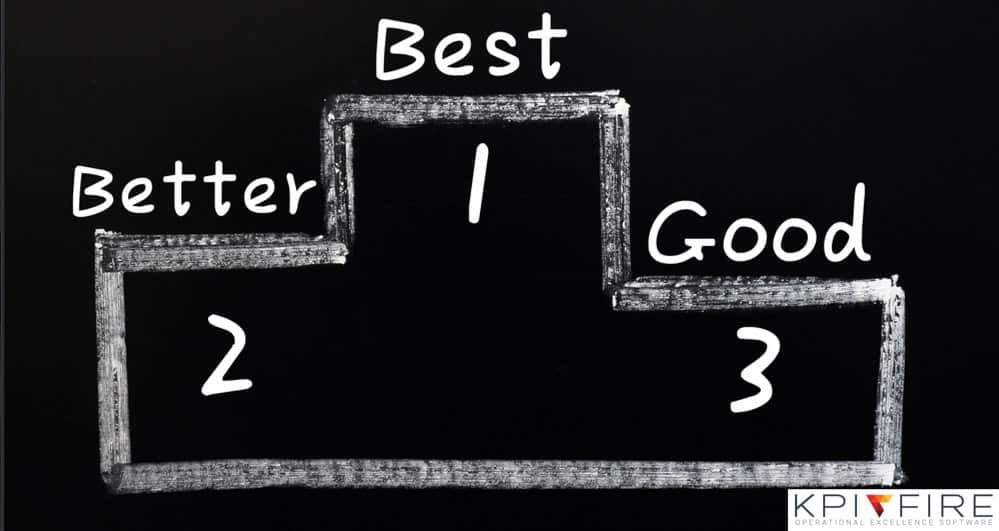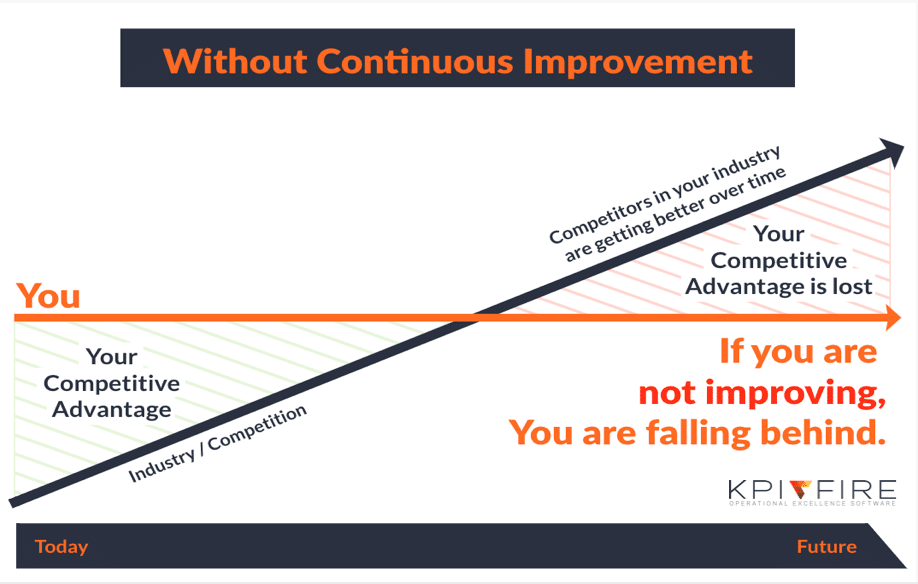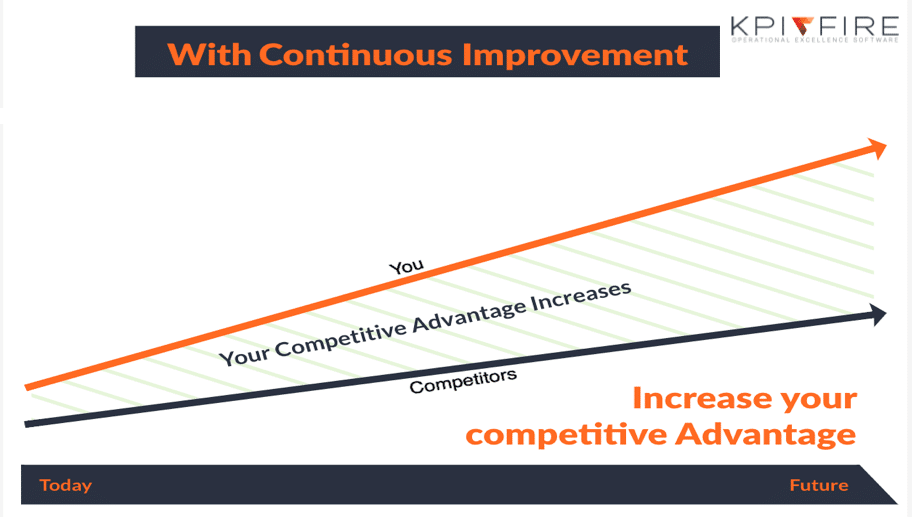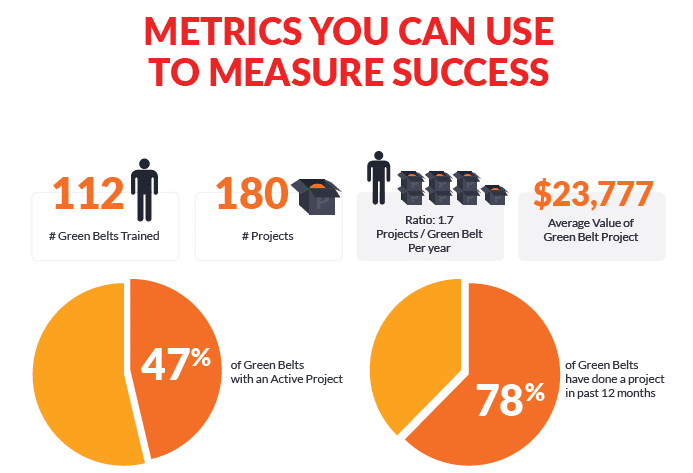Continuous Improvement is an important pillar of any long term business strategic plan. In fact, Continuous Improvement may be the MOST important pillar of every strategic plan. If you are responsible for setting strategic goals or developing a strategic plan, you should absolutely include “Continuous Improvement” as one of your core pillars. This is an easy concept that can be applied to every department in your organization and applied to every discipline.
What happens if your organization is NOT focused on Continuous Improvement? Competition is tough. If you have a competitive advantage today, your competitors are working on taking that away from you. If your competitors are getting better and you are staying the same… You are essentially getting WORSE. You are losing your competitive advantage.
Why is a healthy Continuous Improvement program important?
Without Continuous Improvement in all areas of your business, you are losing your competitive advantage and your business will eventually be gone. A healthy continuous improvement program is therefore critical to long term sustainability of any organization.
With a healthy Continuous Improvement program, your business will maintain or even grow your competitive advantage.
Without a healthy continuous improvement program your competitive advantage is at risk. With Continuous Improvement, your competitive advantage will increase.
How do you know if your Operational Excellence efforts are growing vs dying? Simply put, you need to measure stuff. But, what to measure? The right answer will vary a bit by organization and will depend on how mature your organization is. Here are a few ideas:
“What gets measured, gets managed”~ Peter Drucker
What does a Healthy Continuous Improvement Strategic Plan look like?
The building blocks for a Continuous Improvement program are pretty simple. There are plenty of good examples of how to apply The Toyota Way, or Lean, or Six Sigma, or 2 Second Lean or OKR’s any other flavor of continuous improvement. The foundation is that you establish an expectation for improvements.
- Who will be responsible for “making improvements”?
- What does it mean to “make an improvement”?
- How often will you expect improvements to be made?
Who do you expect to “make improvements”?
- Will you have a small team of people (executives) who are given strategic projects, and everyone else just “does their job”?
- Or, Will you have a dedicated team of “Problem solvers” such as exists in organizations with Six Sigma Belt programs where big expensive projects are given to the Project Management Office or the Black Belts, and smaller projects are given to trainees or to Green Belts
- Or will you have an expectation that everyone in the organization is involved in the process? This is of course the best option because it engages everyone in the problem solving process.
What does it mean to “make an improvement”?
Improvements can be formal or informal. In most organizations with a formal or semi-formal structure they will require that the Improvements be documented. This documentation can take the shape of an A3 form. An A3 form is a size of paper that basically forces you to limit your explanation of the problem and the solution to a single 11 x 17 sheet of paper. This constraint limits the amount of information you can share and forces the users to be concise.
Formal improvements or large budget projects may take the shape of a D.M.A.I.C or P.D.C.A project templates with stage gates to ensure allocation of resources as the project moves forward. If you have formal improvement projects you might require that the type of resource assigned to the project is based on the size of the project or budget required for the project.
Here are a few examples of Improvements that you might not realize are “Improvement projects”
- Capital Projects: purchasing & implementing new equipment
- Acquisitions: Integrating organizations are typically
- D.M.A.I.C. Define, Measure, Analyze, Improve, Control projects are typical projects in Six Sigma.
- PDCA or Plan,Do,Check,Act projects are a workflow frequently used by Lean practitioners.
- Quick Win or Just do it projects. These are quick & easy projects where the documentation may be much less than a DMAIC or PDCA project.
How Often do we expect improvements to be made?
This is the question that is most often left unanswered. Many organizations go through the painstaking process of developing a green belt program, training green belts but then don’t establish a regular cadence for DOING projects. You may get some benefit by simply teaching people the skills, but you are missing out on a great opportunity to regularly advance your organization by not setting a goal related to frequency of projects.
Here are a few examples from Best-in-class Continuous Improvement programs:
- Healthcare: Requiring all managers to submit 2 small or one large improvement per quarter.
- Electronics manufacturer: “We require all employees to submit 2 ideas for improvements and keep score as part of our annual evaluation.
- Building Materials Manufacturer: “All of our greenbelts are required to perform at least 1 project per year to keep their Green Belt certification status and corresponding pay grade”
Ultimately, implementing a Continuous Improvement program is sort of like eating a healthy diet and exercising. You know you should do it, and even if you are not doing it perfectly, doing something is better than doing nothing. If you would like to have a chat with us to discuss how you can move down the path and make Continuous Improvement a competitive advantage in your organization, contact us.







